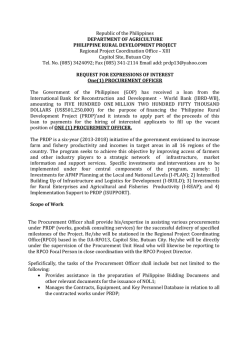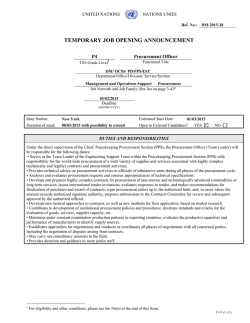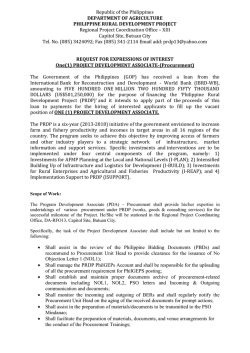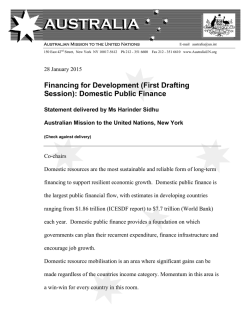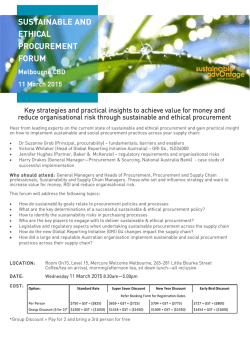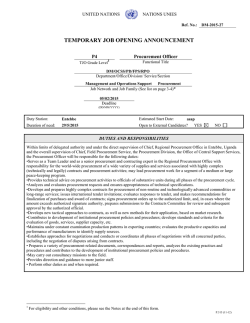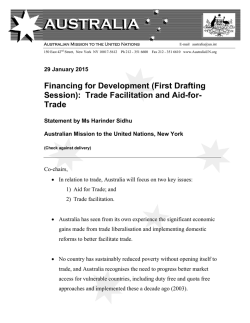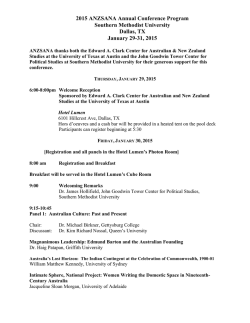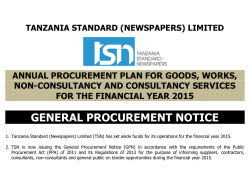
2015-16 Pre-Budget Submission
3 February 2015 Budget Policy Division Department of the Treasury Langton Crescent PARKES ACT 2600 [email protected] 2014-15 Pre-Budget Submission Consult Australia welcomes the opportunity to make this submission to the 2015-16 Commonwealth Budget. In providing our recommendations, we are mindful of the Government’s commitment to fiscal responsibility, together with its twin goal of deficit reduction. Consult Australia is the industry association that represents the business interests of consulting firms operating in the built and natural environment. Our member firms’ services include, but are not limited to: design, architecture, technology, engineering, surveying, legal, and management solutions. We represent an industry comprising some 48,000 firms across Australia, ranging from sole practitioners through to some of Australia’s top 500 firms. Collectively, our industry is estimated to employ over 240,000 people, and generate combined revenue exceeding $40 billion a year. Consult Australia’s recommendations for the 2015-16 Budget, consistent with our submissions to the Productivity Commission and House of Representatives inquiries into better provision of public infrastructure, focus on opportunities to deliver better value for money for the taxpayer when procuring infrastructure, supporting access to skills and driving productivity across the economy. Around 40 percent of our industry’s work is undertaken for public sector clients, and our member firms have played vital roles in the creation of some of Australia’s iconic public infrastructure, including road, rail, hospital, airport, educational facilities, water and energy utilities, justice, aged care, sports stadia, and urban renewal projects. Accordingly, we have substantial experience relating to a number of policy issues surrounding the provision of public infrastructure, including opportunities for government to deliver better value-formoney outcomes for taxpayers. This submission will highlight a number of opportunities for government to achieve improved outcomes as it provides vital public infrastructure, while also supporting the needs of industry to play our part in developing those projects. These vary from best practice procurement policy, which presents an opportunity to achieve “more for less,” through to funding and financing infrastructure, and overcoming challenges relating to the provision of skills to the built environment sector. Many of our suggestions have already been made in the context of the Productivity Commission’s recent report into Public Infrastructure, and this submission should be read in conjunction with the recommendations of that report. Page 1 of 7 2015-16 Pre-Budget Submission Part 1. Procurement Reform Delivering Value-for-Money: Procurement Reform A number of reports commissioned by both government and industry have highlighted the need for procurement reform to ensure that each dollar of public spending achieves optimal value. Focusing on different aspects of procurement, these reports estimate the cost impact of poor procurement as being significant. In the first part of this year, Consult Australia will be releasing our own study into the cost and impact of poor procurement policies and practices. The report will find that through a small number of improvements to procurement policy and practice, significant savings can be made, together with a reduction in delays and improvements to the quality of project outcomes. Combined, these results will lead to a positive impact on the Australian economy through an increase to GDP and job creation. Following the report’s release we would be pleased to discuss its findings and recommendations with any representatives of Treasury. They will be a small number of measures that are achievable and relatively easy to implement. Underlying many of the issues in procurement that can be individually addressed are their causes: the lack of required skills within agencies responsible for procuring goods and services, and cultural aspects, that lead to relevant officers not fully appreciating how risk can be best managed. These issues have arisen through no fault of government agencies, following (for example) outsourcing of a number of functions, but must be addressed to realise optimal outcomes for taxpayers. To this end, Consult Australia has suggested the creation of a Centre for Procurement Excellence as one measure that could improve performance across all spheres of government (see Annex A). Consult Australia would welcome the opportunity to further discuss improvements to procurement policy and practice, and in particular, would see great value in briefing relevant representatives on our forthcoming report into public sector procurement and the opportunities for improvement. Page 2 of 7 2015-16 Pre-Budget Submission Part 2. Improved Access to Skills Reintroducing targeted Industry Outreach Officers (IOOs) Consult Australia was disappointed to see the Government abandon the Industry Outreach Officer program in the 2014 Federal Budget. The Industry Outreach Officer programme was a proven success in informing and communicating with industry on all aspects immigration and visa processing and policy. The expert assistance provided through the IOOs supported a clear flow of information between employers and the Department, ensuring up to date information regarding changes to policy and leglsation was communicated to firms in a timely easy-to-understand format. In the case of our industry, the professional relationship built between the IOOs and Consult Australia was a big factor in the enhanced level of understanding of the industry and government on the needs of each in the skilled migration and temporary migration arena. For our member firms, who have increased reliance on specialist engineers and other technical professions, a detailed understanding by the Department of the particular issues they face, helped ensure that their skilled migration needs were efficiently met. Consult Australia recommends the reintroduction of IOOs focusing on specific industries, such as ours, that contribute substantially to broader productivity, but where this economic contribution is impeded through ongoing systemic skills shortages in particular areas. This more tailored approach to the reintroduction of the IOO program recognises the need to apply fiscal discipline, but also the benefits of the program in supporting access to skills in those areas of the economy driving growth. Removing Barriers to Accessing Skills: Labour Market Testing The temporary skilled migration program, centred on the subclass 457 visa, is market-driven. It helps employers fill labour needs when suitable local options are unavailable. Compared with using locallybased people, the 457 visa is an expensive option for employers due to the additional lead time to fill positions, the cost of bringing workers to Australia, and program requirements such as responsibility for the cost of travel to their home country at the end of their contract. This is in addition to wages which must be as good or better than what would be provided to an Australian worker performing the same or similar role. Employers therefore test the labour market for every hiring decision. The recent introduction of regulation for that process—Labour Market Testing (LMT)—imposes unnecessary costs on employers and government alike and it is inappropriate for the government to be involved in that market-driven process. Government resources would be better spent on enforcement of existing rules on the use of the subclass 457 visa. Targeted, risk based, enforcement would be particularly powerful for ensuring that abuse of the system and workers does not occur, or is quickly detected and eliminated. Page 3 of 7 2015-16 Pre-Budget Submission Other Measures to Improve the Skilled Migration Process A number of other measures that are currently part of the skilled migration process create unnecessary red tape for business, and a costly administrative burden on the Department of Immigration. These were canvassed in our submission to the Department’s Review of Skilled Migration and the 400 Series Visa Programs1. Some of those measures include: - Health insurance requirements, which could be improved through a more pragmatic approach; - Caps on sponsorship numbers, which create an additional red tape burden, while achieving the same outcome; - Streamlining accreditation status; - Enhance compliance monitoring by conducting more risk-based and targeted enforcement checks rather than creating new regulatory processes. More Flexible Childcare Critical to industry productivity is maximising workforce participation, diversity and inclusion. Consult Australia works closely with our member firms to share best practice in relation to flexible working that helps to attract and retain employees who are balancing work and family commitments. In parallel, it is critical that the Government complements industry best practice through a more flexible approach to child care policy and incentives. Consult Australia looks forward to the Government’s imminent consultation on a new families package to deliver more affordable, available childcare. Consult Australia will be pleased to participate in this consultation. In our recommendations to the Productivity Commission Inquiry into Childcare we have already recommended that: 1. Changes to child care to make it more accessible to parents who do not work standard hours should be extended beyond shift working patterns and include the variable work patterns of professionals in modern and global companies. 2. Regulation to ensure that child care centres are safe should remain strong, but consideration should be given to allowing centres to provide varying levels of quality in terms of educational provision to meet the varying needs of parents and their children. 3. Remove restrictions on the use of in home care as approved care. 4. Nanny and au pair services should be reclassified as approved care 5. The cost of child care should continue to be shared between parents and the government on behalf of the general public. If these recommendations are followed, and restrictions on the flexible use of childcare are removed, more parents will be encouraged to utilise nannies and other types of in home care and return to work. For a limited Government budget allocation, more parents will ‘do the sums’ and realise that they will be better off if they return to work and select from a wider suite of care options for their children. 1 See https://consultaustralia.com.au/docs/default-source/policy/consult-australia-submission---review-ofskilled-migration-and-400-series-visas---20141024.pdf Page 4 of 7 2015-16 Pre-Budget Submission Part 3. Investing in Infrastructure Delivering Productivity Improvements: Investing in Infrastructure Infrastructure provision has lagged population growth in Australia for three decades. If we are to seize an advantage in what is the fastest growing region of the world’s economy, obstacles to the development and delivery of infrastructure must be overcome. Since 2004, Australia’s strong economy, supported by the mining boom and AusLink investments, together with an increase in private financing has seen some improvements in the delivery of infrastructure projects that have helped to manage congestion costs and supply constraints. The benefits of this investment to our productivity are clear with estimates suggesting economic benefits of approximately $2.85 for every $1 invested in highways, rail and urban public transport alone. However, while positive, these improvements are against a growing infrastructure deficit that puts at risk our ability to maintain economic prosperity in the longer term. Increased infrastructure investment that improves economic capacity and productivity must be the first policy response to the challenges arising from increasing congestion and declining quality of life in Australian cities, and will have the added benefit of easing pressure on migration policy and achieving a more sustainable future. Recent public inquiries into the provision of infrastructure in Australia have highlighted the importance of this issue, and the demand of the Australian public for increased investment in the development and delivery of infrastructure. Their discussion and recommendations provide a roadmap for government to set about rectifying the backlog of infrastructure. The Productivity Commission made a number of important findings and recommendations to improve infrastructure delivery in Australia, ranging from governance arrangements to finance and risk management. The report is an important statement of the challenges and opportunities to develop more and better quality public infrastructure in Australia. Many of the Productivity Commission’s recommendations addressing project governance and risk management have been adopted by the Government, by way of an update to the National Guidelines for Project Delivery. This update should be supported as a matter of priority. Similarly, the recent House of Representatives Inquiry into Planning, Procurement and Funding for Australia’s Future Infrastructure made a number of important recommendations. These include: • recommending that the Australian Government continue to facilitate the development of a pipeline of public infrastructure projects, with consideration given to the adequacy of the fifteen year projection currently used; • that innovative financing and funding models (including user charging, inverted bidding, asset recycling and promotion of infrastructure bonds) be considered and further developed; • that tender processes be made more efficient, cost effective and flexible; that Infrastructure Australia’s role is enhanced to incorporate wider procurement functions; and • that through COAG, better risk management strategies in infrastructure procurement are developed. Each of these recommendations are supported by Consult Australia, and offer the potential for the benefits of public infrastructure to be enjoyed by Australians, with cost savings realised through the development phase of each project. Page 5 of 7 2015-16 Pre-Budget Submission We would be pleased to discuss further the issues raised in this submission. To do so, please contact Robin Schuck, Senior Advisor, Policy & Government Relations, on [email protected] or phone 02 9922 4711. Yours sincerely, Megan Motto Chief Executive Page 6 of 7 Annex A: A Procurement Centre of Excellence Establishing an independent Procurement Centre of Excellence to develop and implement best practice procurement and deliver value for money. With large amounts of public funds being spent on infrastructure, it is incumbent on governments to ensure they get maximum value for money through the procurement process. To buy wisely you need wise buyers: there are substantial opportunities for governments and business to share expertise, and identify and deliver solutions that improve productivity and value for money across the procurement process. The Australian Government spent nearly $42 billion across some 82,000 contracts valued over $10,000 in 2011-12. A one per cent efficiency dividend would equate to nearly half a billion dollars in savings. Including the value of procurement across 6 states, 2 territories and 562 local governments: the opportunities to translate these savings into new infrastructure, hospital beds, police and other essential government services are substantial. In the construction sector alone, a 2009 report estimated the cost of disputation at $7 billion per year, a figure that is likely to have grown. Similarly, a 2008 survey of pressure points in the Australian construction industry found that poor procurement practices had led to 26 percent of projects worth over $1 billion in Australia running over budget by $200 million or more, while a 2006 study found that only 56 percent of projects were completed on time. Better procurement practices could have prevented, or limited this waste. To overcome persistent deficiencies in procurement skills and practices, we recommend a whole of government approach supporting the establishment of an Australian Centre for Procurement Excellence, building on the work of the Australasian Procurement and Construction Council (APCC): We recommend: The Procurement Centre of Excellence expand the APCC’s role and remit, broadening government engagement and building on work across jurisdictions considering efficiencies in procurement. The Centre would be tasked with building a stronger relationship between government and business and supporting best practice procurement in Australia at all levels of government. The Centre should: • • • • be established as independent of government; build stronger linkages between government and with industry sectors; provide transparent expert advice to all levels of government; and develop guidelines, build capability and improve standards. The Board of the Centre for Procurement Excellence should include equal levels of representation from industry and government. The Council of Australian Governments (COAG) in collaboration with the Business Advisory Forum should lead a Government & Business Procurement Summit in 2015 to build the mandate supporting the establishment of the Procurement Centre of Excellence. The Summit should: • • Highlight opportunities across all sectors to share expertise, increase productivity and deliver savings and efficiencies through better procurement; Identify key stakeholders, determine the terms of reference and appropriate governance supporting the Procurement Centre of Excellence. Page 7 of 7
© Copyright 2025
